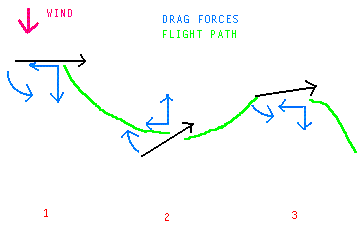 In the following diagram we are looking vertically downwards on an arrow
and what happens to it in a cross wind. i.e. we are ignoring its vertical
trajectory and any vertical wind effects.
In the following diagram we are looking vertically downwards on an arrow
and what happens to it in a cross wind. i.e. we are ignoring its vertical
trajectory and any vertical wind effects.While the basics of how an arrow flies have already been discussed it may be worth pulling the various bits together to cover how wind affects where an arrow hits the target.
Like most topics relating to arrow flight, the effect of wind on an arrow needs to be looked at in four dimensions; length,width, height and time. As this is a good recipe for getting a headache I will break wind behaviour down into looking at the affect of a cross wind and a head wind separately. How drag etc. affects the arrow has already been covered so I shan't repeat all the details. I will assume these sections have already been read.
 In the following diagram we are looking vertically downwards on an arrow
and what happens to it in a cross wind. i.e. we are ignoring its vertical
trajectory and any vertical wind effects.
In the following diagram we are looking vertically downwards on an arrow
and what happens to it in a cross wind. i.e. we are ignoring its vertical
trajectory and any vertical wind effects.
At '1' the arrow has just left the bow. The net wind velocity (arrow velocity plus cross wind velocity) acts on the pile,shaft and fletchings to move the arrow sideways, slow the arrow down in the original direction of flight and rotate the arrow in an anti-clockwise direction. The arrow ends up travelling downwind and rotating anti-clockwise. Once the arrow has rotated past the 'straight' position (where the arrow is pointing in the net wind direction) then the drag forces act to slow up the rotation and decelerate the sideways movement.
At '2' the arrow has stopped moving downwind and has reached the maximum amount of anti-clockwise rotation. The total drag force is now acting to slow the arrow down, move the arrow upwind and rotate the arrow in a clockwise direction. The arrow ends up travelling upwind and rotating clockwise. The reverse of what happened between '1' and '2'.
At '3' the arrow has stopped moving upwind and has reached the maximum amount of clockwise rotation. And so on...
This process continues until the arrow hits the target. The green line represents the overall path of the arrow i.e. an overall movement down wind but within this the arrow moves from side to side. The net wind drift you end up with on the target depends on not only the strength of the cross wind but the drag and rotational properties of the arrow. The relationship between the strength of the cross wind and the wind drift you end up with is therefore highly complicated.
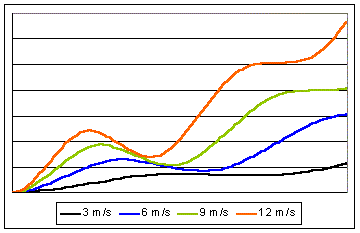 The diagram presents the simulated flight paths of a perfectly
shot arrow with a perfectly tuned setup as the strength of the cross wind
varies. The arrow is shot so that in no wind the arrow hits the centre
of the target i.e. no aim-off. As we are only looking at what happens in
the horizontal plane the effect of gravity has been 'removed'.
The diagram presents the simulated flight paths of a perfectly
shot arrow with a perfectly tuned setup as the strength of the cross wind
varies. The arrow is shot so that in no wind the arrow hits the centre
of the target i.e. no aim-off. As we are only looking at what happens in
the horizontal plane the effect of gravity has been 'removed'.
The wind drifts in the diagram are represented by the vertical position where each arrow flight path line hits the right side of the graph (the target). The following general characteristics can be seen:-
- The higher the cross wind speed than the greater the wind drift
- There is no direct relationship between the cross wind speed and the wind drift. For example the change in wind drift between wind speeds of 3 m/s and 6 m/s is much greater than the change between 6 m/s and 9 m/s.
- The higher the cross wind speed than in general the greater is the side to side movement of the arrow.
- The higher the cross wind speed then the faster is the side to side movement of the arrow.
Because the amount of wind drift you get is so tied in to the rotation characteristics of the arrow then the wind drift becomes very sensitive to the tuning of the bow /arrow setup, or to the quality of the shot which amounts to much the same thing. (Tuning defines the rotational properties of the arrow as it leaves the bow).
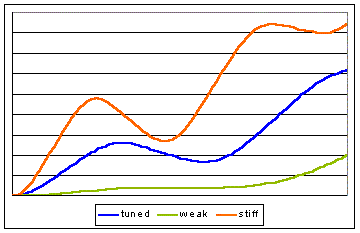 The graph illustrates the wind drift variation you get with
a perfectly tuned setup, a 'stiff' setup and a 'weak' setup everything
else being the same. (note that the relative behaviour between the weak
and stiff arrows depends on the direction of the cross wind).
The graph illustrates the wind drift variation you get with
a perfectly tuned setup, a 'stiff' setup and a 'weak' setup everything
else being the same. (note that the relative behaviour between the weak
and stiff arrows depends on the direction of the cross wind).
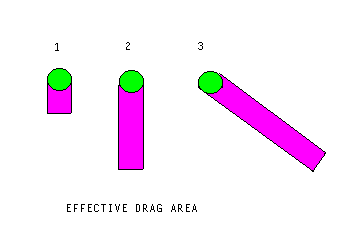 The more total drag force there is in the horizontal plane reducing the arrow's kinetic energy then the lower the arrow will hit on the target. The
drag force depends on the drag area. The diagram illustrates
how the orientation the arrow has affects the drag area acting to reduce
the arrow's kinetic energy. (the description is not really technically
correct but it puts the basic idea over better)
The more total drag force there is in the horizontal plane reducing the arrow's kinetic energy then the lower the arrow will hit on the target. The
drag force depends on the drag area. The diagram illustrates
how the orientation the arrow has affects the drag area acting to reduce
the arrow's kinetic energy. (the description is not really technically
correct but it puts the basic idea over better)
If the arrow was always pointing in the direction it was travelling (which is in practice never) then the drag area slowing the arrow down would be the cross sectional area of the pile and the total surface area of the arrow shaft and fletchings (the 'shear drag' scenario). Because the arrow always has some vertical offset angle then this drag area is the pile area plus some shaft drag area (fig 1). As the vertical offset angle increase this shaft drag area increases (fig 2). If you take an arrow with a given vertical offset angle and rotate it in the horizontal plane (fig 3) then the shaft area again increases and this drag increases.
The best way to see this effect is to hold an arrow up, pile towards you, in front of your eyes and then then move the nock of the arrow up and down and from side to side while thinking 'the area I can see roughly corresponds to the drag I will get'.
We have seen above that in a cross wind an arrow rotates. The more the arrow rotates then the more drag slowing the arrow down there will be. The effect of a cross wind therefore will be to make the arrow hit lower on the target. The stronger the cross wind the more the arrow will 'fly sideways' and the lower on the target the arrow will hit.
The point where an arrow hits the target in a cross wind is the combination of the above horizontal and vertical effects. These two effects are not independant of each other. The overall effect of a cross wind on an arrow is therefore very complicated and difficult to 'get your head around'. All you can really do is set up the basic physics in a simulator, which handles all these complications automatically, and see what happens.
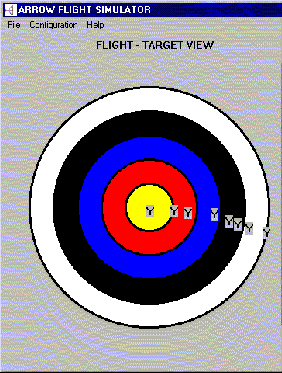 The picture illustrates the general pattern of where an arrow
hits as a the cross wind speed increases. Its only a general guide as the
pattern in detail depends on the wind, distance, arrow properties and the
initial arrow flight characteristics. As well as being blown sideways the arrow also drops vertically.
The picture illustrates the general pattern of where an arrow
hits as a the cross wind speed increases. Its only a general guide as the
pattern in detail depends on the wind, distance, arrow properties and the
initial arrow flight characteristics. As well as being blown sideways the arrow also drops vertically.
The opposite of a cross wind is a head/tail wind. How arrow flight behaves in a head/tail wind is described at the following link (head/tail wind).
Normally the wind direction will be somewhere between a head/tail wind and a cross wind so where the arrow eventually hits will be a combination of both these effects.
Last Revision 1 July 2009